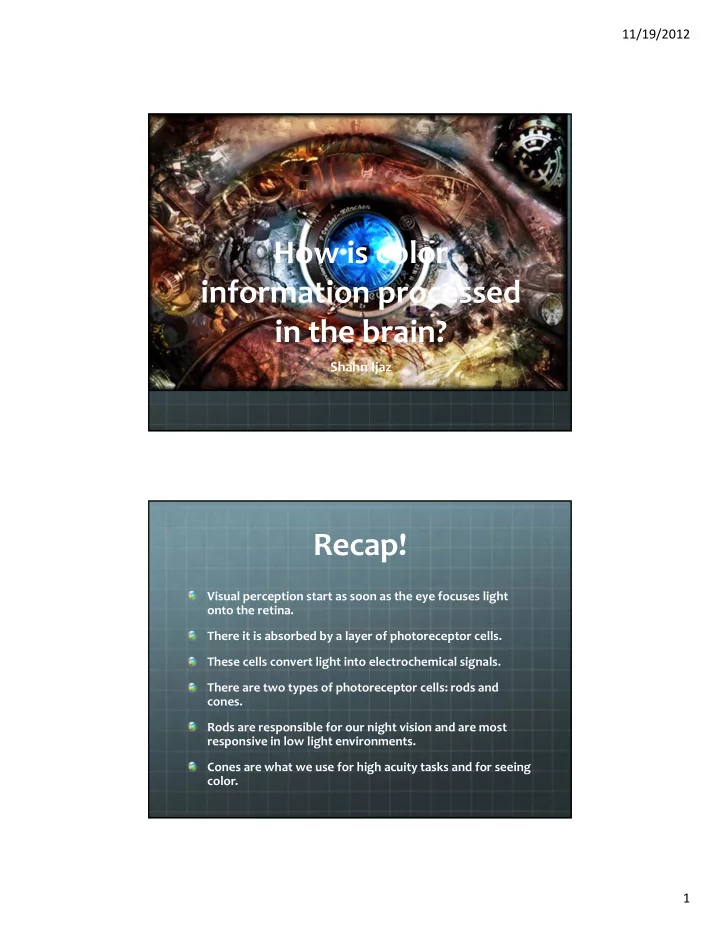

11/19/2012 How is color information processed in the brain? Shahn Ijaz Recap! Visual perception start as soon as the eye focuses light onto the retina. There it is absorbed by a layer of photoreceptor cells. These cells convert light into electrochemical signals. There are two types of photoreceptor cells: rods and cones. Rods are responsible for our night vision and are most responsive in low light environments. Cones are what we use for high acuity tasks and for seeing color. 1
11/19/2012 Visible Light Spectrum Cone cells There are three types of cones: S cones, M cones, and L cones (short, medium, long) The top portion of the cone is where the photopigments are embedded as membrane proteins 2
11/19/2012 How cones work Individual cones are actually color blind. Their response is merely a reflection of the number of photons that they capture. What this means is that the change in the cone’s membrane potential could have been triggered either by exposure to a lot of photons which the receptor is relatively insensitive to, or a few photons to which the receptor is most sensitive. Our actual color processing occurs when the activity of the different classes of cones are compared at higher levels in the visual pathway. 3
11/19/2012 Where does the signal go from the cones? Signals from the photoreceptors go through a network of interneurons until they reach the ganglion cells. The color information is processed in the ganglion cells and then sent through the optic nerve . From the optic nerve, the signal travels to the thalamus into a cluster of nerve cells called the lateral geniculate nucleus (LGN). Finally, the signal arrives at the primary visual cortex. 4
11/19/2012 Ganglion Cells They are neurons in the back of the retina that receive signals from rods and cones via different intermediate cells. They are the cells that transmit information to the brain. There are 4 main types of ganglion cells: Midget cells, parasol cells, bistratified cells, and photosenstive cells. While each have different purposes, they all have long axons that extend to the brain in the form of the optic nerve Types of Ganglion Cells Midget Cells project to the parvocellular layer of the LGN. 80% of ganglion cells are midget cells. Parasol cells project to the magnocellular layer of the LGN. About 10% of ganglion cells are parasol cells. Bistratified cells project to the koniocellular layer of the LGN and make up about 10% of the ganglion cells. Photosensitive ganglion cells are unique in that they can respond to light in the absence of rods and cones. They contribute to setting our circadian rhythm and pupillary light reflex. 5
11/19/2012 Lateral Geniculate Nucleus The LGN separates retinal inputs into two parts: one containing color and fine structure and the other containing contrast and motion. There are three main layers of the LGN: magnocellular layers (responsible for the pereption movement and depth), parvocellular layers ( receive info from red and green cones as well as fine details in form), and koniocellular cells ( receive info from blue cones) Colorblindness Color vision deficiencies result from either the inherited failure to make one more cone pigments or an alteration in the normal absorption spectra of the cone pigments. Normally, people can match any color according to the relative intensities of long, medium, and short wavelength cones. This makes color vision trichromatic. About 5% of the male population and 1% of the female population can perceive only two of the three main colors. Protanopia is where all color matches are achieved using only blue and green light. Deuteranopia is where all color matches are done with blue and red light. 6
11/19/2012 Color Blind Test! I can actually see this one! 7
11/19/2012 Sources: http://www.ncbi.nlm.nih.gov/books/NBK11059/ http://www.webexhibits.org/causesofcolor/1C.html http://learn.colorotate.org/how ‐ do ‐ we ‐ perceive ‐ color.html http://brainconnection.positscience.com/topics/?main=ana t/vision ‐ work http://www.tedmontgomery.com/the_eye/colortst/colorts t.html The almighty google Take Home Message Color Vision is determined by the relative firing of the three types of cone cells. This info is interpreted by the ganglion cells and then sent to the LGN where the info is refined to create a picture which is processed further in the primary visual cortex to create a picture. 8
Recommend
More recommend